|
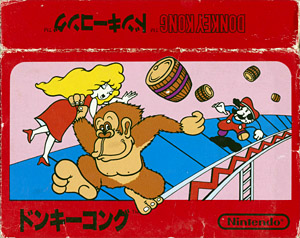
|

|
|
ドンキーコング
©1981 Nintendo Co.,Ltd.
Release: 1983-07-15 (¥4500)
Cartridge HVC-DK
Action/Platform game
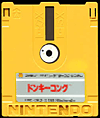

|
Released in Japan (Disk Writer) as
DONKEY KONG
( FMC-DKD )
|
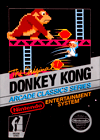

|
Released in America as
DONKEY KONG
( NES-DK-USA )
|
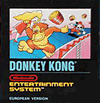

|
Released in Europe as
DONKEY KONG
( NES-DK-XXX )
|
|
Here is the Famicom port of Nintendo's arcade classic Donkey Kong.
Do we still need to introduce the universally beloved barrel-throwing gorilla ?
Donkey Kong, a large and angry ape, has kidnapped Lady (aka Pauline)
and climbed to the top of a tall and perilous construction site, where he keeps her
prisoner. Without hesitation, her boyfriend Jumpman (aka Mario), a
little mustached carpenter with red overalls, a blue shirt and a hat, flies to her
rescue. The little man is the gorilla's original caretaker and he is also ready to
teach the large ape a good lesson that he will not soon forget... The player must guide
Mario through three different stages and eventually rescue the beautiful damsel
in distress. But the task won't be easy and the gorilla will do anything to protect and
uphold what now belongs to him. In the first screen, Mario must run up a series
of metallic girders while avoiding barrels that the ape throws down at him. The first
barrel also ignites an oil drum located at the bottom of the screen, which in turn
generates fireballs that go chase after Mario. Although the carpenter can only
jump, avoid enemies or climb up ladders, he nevertheless has a way to defend
himself - hammers are sometimes available and can be used as improvised weapons
for a short amount of time, and crush anything that dares cross their path. The
second screen features elevators, evil bouncing springs and a wandering fireball,
as well as two bonus items - Pauline's umbrella and purse that the player
can collect for extra points. Finally, the third screen is made out of four large
platforms hold in places by eight yellow rivets. Mario must jump over every
single rivet to make them disappear, forcing the large construction to collapse and
then trapping the giant gorilla, thus rescuing Pauline from her predicament.
|
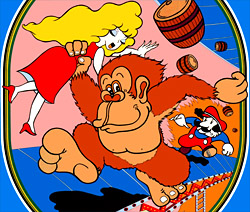 The story of Donkey Kong is a fascinating one and it began in 1980,
when Hiroshi Yamauchi, president of Nintendo in Japan,
decided to expand the company into the United States. He delegated this
huge responsibility to the man who married Yoko, his beautiful daughter.
Although Minoru Arakawa (Hiroshi Yamauchi's son-in-law) originally
graduated as a civil engineer, he accepted the challenge and moved to New York
in 1980. His first task was to break into the lucrative arcade business and he started
to import several Nintendo arcade games, and especially a
Space Invaders/Galaxian clone called Radar Scope. The game was a success
in Japan and Minoru hoped it would become the next killer game, and
therefore ordered a large quantity of three thousand units for the American
market. However, when the machines arrived, the public interest had evaporated and
the young company was on the brink of financial disaster. In a desperate move,
Minoru contacted his father-in-law and asked for a replacement game (the ROM
inside the units could easily be replaced, and the cabinet refurbished and repainted).
However, all the key development teams in Japan (the famous R&D teams)
were already busy and didn't have enough resources to create a brand new game on such
a short notice. So Hiroshi Yamauchi assigned a rookie designer named
Shigeru Miyamoto the task of developing the game, and although he had already
been at the company for a few years as a graphic designer, the young man had never
actually designed a game before. Helped by Nintendo veteran Gunpei Yokoi,
he first started working on a concept based on the popular cartoon Popeye
(Nintendo was negotiating the rights with King Features at the time),
but as the deal fell through, he decided to come up with his own idea.
The story of Donkey Kong is a fascinating one and it began in 1980,
when Hiroshi Yamauchi, president of Nintendo in Japan,
decided to expand the company into the United States. He delegated this
huge responsibility to the man who married Yoko, his beautiful daughter.
Although Minoru Arakawa (Hiroshi Yamauchi's son-in-law) originally
graduated as a civil engineer, he accepted the challenge and moved to New York
in 1980. His first task was to break into the lucrative arcade business and he started
to import several Nintendo arcade games, and especially a
Space Invaders/Galaxian clone called Radar Scope. The game was a success
in Japan and Minoru hoped it would become the next killer game, and
therefore ordered a large quantity of three thousand units for the American
market. However, when the machines arrived, the public interest had evaporated and
the young company was on the brink of financial disaster. In a desperate move,
Minoru contacted his father-in-law and asked for a replacement game (the ROM
inside the units could easily be replaced, and the cabinet refurbished and repainted).
However, all the key development teams in Japan (the famous R&D teams)
were already busy and didn't have enough resources to create a brand new game on such
a short notice. So Hiroshi Yamauchi assigned a rookie designer named
Shigeru Miyamoto the task of developing the game, and although he had already
been at the company for a few years as a graphic designer, the young man had never
actually designed a game before. Helped by Nintendo veteran Gunpei Yokoi,
he first started working on a concept based on the popular cartoon Popeye
(Nintendo was negotiating the rights with King Features at the time),
but as the deal fell through, he decided to come up with his own idea.
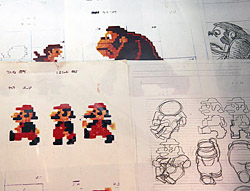 This is how Donkey Kong slowly took shape - inspired by The Beauty and the Beast,
Miyamoto created a large ape-like creature, unlikely pet of a goofy looking
carpenter called Jumpman. The game was nearing completion and rumors even
suggest that Miyamoto wrote the distinctive music all by himself
(Yukio Kaneoka will be later credited for the Famicom soundtrack).
As for the name, he decided that Kong would clearly fit the large antagonist,
but he also wanted the suggest the goofy nature and comic stubbornness of the giant
ape. In an interview for the official Nintendo japanese site, Miyamoto
reveals that he used his Japanese/English dictionary, and 'Donkey' came up as
a translation for manuke (meaning 'dumb' in Japanese). As a result, the game was given the
euphonious name Donkey Kong. However, back in the United States,
the staff at NOA was horrified and
could not hide its disbelief about the game. But Minoru (pressured by
Yamauchi) went ahead, translated the instructions, renamed the damsel in
distress Pauline (named after Polly, wife of NOA's employee
Don James) and the goofy carpenter Mario (based on Minoru's
warehouse landlord at the time, Mario Segali). For some obscure reasons,
the stage order was changed between the original Japanese and American
versions - instead of barrel-conveyor-elevator-rivets, the American
version featured several loops, starting with barrel-rivets, then
barrel-conveyor-rivets and so forth... But despite the initial disbelief,
Donkey Kong became a smash hit and the rest is, as they say, history. I
invite you to read David Sheff's excellent book 'Game Over: How
Nintendo Conquered the World', where the fascinating story of Donkey Kong
(along with Nintendo's) is richly told with fascinating historical details.
This is how Donkey Kong slowly took shape - inspired by The Beauty and the Beast,
Miyamoto created a large ape-like creature, unlikely pet of a goofy looking
carpenter called Jumpman. The game was nearing completion and rumors even
suggest that Miyamoto wrote the distinctive music all by himself
(Yukio Kaneoka will be later credited for the Famicom soundtrack).
As for the name, he decided that Kong would clearly fit the large antagonist,
but he also wanted the suggest the goofy nature and comic stubbornness of the giant
ape. In an interview for the official Nintendo japanese site, Miyamoto
reveals that he used his Japanese/English dictionary, and 'Donkey' came up as
a translation for manuke (meaning 'dumb' in Japanese). As a result, the game was given the
euphonious name Donkey Kong. However, back in the United States,
the staff at NOA was horrified and
could not hide its disbelief about the game. But Minoru (pressured by
Yamauchi) went ahead, translated the instructions, renamed the damsel in
distress Pauline (named after Polly, wife of NOA's employee
Don James) and the goofy carpenter Mario (based on Minoru's
warehouse landlord at the time, Mario Segali). For some obscure reasons,
the stage order was changed between the original Japanese and American
versions - instead of barrel-conveyor-elevator-rivets, the American
version featured several loops, starting with barrel-rivets, then
barrel-conveyor-rivets and so forth... But despite the initial disbelief,
Donkey Kong became a smash hit and the rest is, as they say, history. I
invite you to read David Sheff's excellent book 'Game Over: How
Nintendo Conquered the World', where the fascinating story of Donkey Kong
(along with Nintendo's) is richly told with fascinating historical details.
|
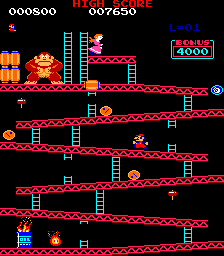 The original Donkey Kong arcade game was released in 1981 (picture on the left), and thanks to
its huge commercial success, the game was ported to virtually every single video
game system at the time (including Nintendo's Game & Watch series)
and the characters were licensed and appeared on a wide variety of products (such
as books, cereals, boardgames) as well as televisions shows and cartoons. A sequel
to the game called Donkey Kong Jr followed in 1982 and starred
Donkey Kong's young son (Mario is the main antagonist in this second
episode). Curiously, Donkey Kong II was not released in the arcades, but as a
multi-screen Game & Watch LCD game in 1983, and used the same formula laid
down by Donkey Kong Jr. The arcade game Donkey Kong 3 then followed in
1983 and featured Sutanrī (aka Stanley), a young man who must protect
his greenhouse from Donkey kong's wrath. At that point in time, Donkey Kong
became one of Nintendo's mascot franchise and was featured in countless titles,
from Game & Watch games (such as Donkey Kong Circus or
Donkey Kong Hockey) to Famicom spin-offs (such as
Donkey Kong Jr. no Sansū Asobi, aka Donkey Kong Jr Math). But, as
time went by, Donkey Kong slowly became overshadowed by other popular
Nintendo characters such as Mario or Link, and although the
ape made a few cameo appearances (such as in Super Mario Kart released in 1992),
it remained relatively quiet. Until 1994. That year, a Game Boy game simply
called Donkey Kong took the original arcade concept and ran with it, creating
a masterpiece and the best game for fans of the original game and art design
(it later inspired Mario vs. Donkey Kong released in 2004 for the
Game Boy Advance). But, most importantly, Super Donkey Kong (aka
Donkey Kong Country in the west) was released for the Super Famicom
and gave the characters and the series a new identity. The iconic character
Donkey Kong was entirely redesigned and the game used pre-rendered 3D
graphics. Well, according to the Super Donkey Kong series, the gorilla
that appears in the early Donkey Kong games is actually named
Cranky Kong (depicted as an ederly ape), and the charismatic gorilla
seen in the Super Donkey Kong series is apparently his grandson
(or his son). The game was a huge success and, naturally, several sequels
followed - Super Donkey Kong 2 (aka
Donkey Kong Country 2 Diddy's Kong Quest, Super Famicom, 1995),
Super Donkey Kong 3 (aka Donkey Kong Country 3: Dixie Kong's Double Trouble!,
Super Famicom, 1996), Donkey Kong 64 (Nintendo 64, 1999) and
Donkey Kong Returns (aka Donkey Kong Country Returns, Wii, 2010).
The early Donkey Kong Country games were also ported to the Game Boy Color
and Game Boy Advance, as well as the Game Boy exclusive
Super Donkey Kong GB (aka Donkey Kong Land, 1995). The classic
Donkey Kong and the new Super Donkey Kong characters have appeared
in countless spin-off games and have appeared as cameos in many Nintendo
games, and the franchise is still going strong today.
The original Donkey Kong arcade game was released in 1981 (picture on the left), and thanks to
its huge commercial success, the game was ported to virtually every single video
game system at the time (including Nintendo's Game & Watch series)
and the characters were licensed and appeared on a wide variety of products (such
as books, cereals, boardgames) as well as televisions shows and cartoons. A sequel
to the game called Donkey Kong Jr followed in 1982 and starred
Donkey Kong's young son (Mario is the main antagonist in this second
episode). Curiously, Donkey Kong II was not released in the arcades, but as a
multi-screen Game & Watch LCD game in 1983, and used the same formula laid
down by Donkey Kong Jr. The arcade game Donkey Kong 3 then followed in
1983 and featured Sutanrī (aka Stanley), a young man who must protect
his greenhouse from Donkey kong's wrath. At that point in time, Donkey Kong
became one of Nintendo's mascot franchise and was featured in countless titles,
from Game & Watch games (such as Donkey Kong Circus or
Donkey Kong Hockey) to Famicom spin-offs (such as
Donkey Kong Jr. no Sansū Asobi, aka Donkey Kong Jr Math). But, as
time went by, Donkey Kong slowly became overshadowed by other popular
Nintendo characters such as Mario or Link, and although the
ape made a few cameo appearances (such as in Super Mario Kart released in 1992),
it remained relatively quiet. Until 1994. That year, a Game Boy game simply
called Donkey Kong took the original arcade concept and ran with it, creating
a masterpiece and the best game for fans of the original game and art design
(it later inspired Mario vs. Donkey Kong released in 2004 for the
Game Boy Advance). But, most importantly, Super Donkey Kong (aka
Donkey Kong Country in the west) was released for the Super Famicom
and gave the characters and the series a new identity. The iconic character
Donkey Kong was entirely redesigned and the game used pre-rendered 3D
graphics. Well, according to the Super Donkey Kong series, the gorilla
that appears in the early Donkey Kong games is actually named
Cranky Kong (depicted as an ederly ape), and the charismatic gorilla
seen in the Super Donkey Kong series is apparently his grandson
(or his son). The game was a huge success and, naturally, several sequels
followed - Super Donkey Kong 2 (aka
Donkey Kong Country 2 Diddy's Kong Quest, Super Famicom, 1995),
Super Donkey Kong 3 (aka Donkey Kong Country 3: Dixie Kong's Double Trouble!,
Super Famicom, 1996), Donkey Kong 64 (Nintendo 64, 1999) and
Donkey Kong Returns (aka Donkey Kong Country Returns, Wii, 2010).
The early Donkey Kong Country games were also ported to the Game Boy Color
and Game Boy Advance, as well as the Game Boy exclusive
Super Donkey Kong GB (aka Donkey Kong Land, 1995). The classic
Donkey Kong and the new Super Donkey Kong characters have appeared
in countless spin-off games and have appeared as cameos in many Nintendo
games, and the franchise is still going strong today.
|
|
This port of Donkey Kong has a few differences with the original arcade
game. First of all, the short introduction sequence was completely removed - in
the original game, Donkey Kong climbs the construction site with Pauline
under his arm and heavily stromps his feet as he reaches the top, causing the metallic
girders to collapse and form the first screen. The 25-meter scale displayed between
screens was also omitted - in the arcade game, each screen represents 25m of the
construction site, from 25m to 100m. Most importantly, the second screen (the
conveyor belt/cement screen also known as the 'Pie Factory' stage) was
completely omitted (probably scrapped because of space limitations within the ROM).
Surprisingly, the Famicom port features sound effects not found on the
original arcade game (such as Mario's footsteps) and a new opening music
(credited to Yukio Kaneoka).
|
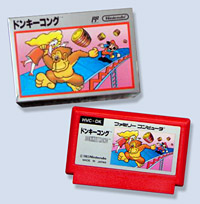 In 1983, the Famicom version tested here was one of the Famicom system
launch titles (with Donkey Kong Jr and Popeye), but it
wasn't the case for the American NES launch two years later (the game was
probably a bit too old). In Japan, Donkey Kong was part of the
'Cassette Line' series (popularly known as the "pulse line" series) which
counted fourteen titles, and was later released again with an illustrated
cartridge label and a silver box (arguably harder to find than the line
version, picture on the right). As a side note, Donkey Kong was
also released for the Famicom Disk Writer in 1988.
As for the American releases, Donkey Kong was part
of what is now commonly called the 'Black Box' series.
Nintendo own releases for the NES early years (1985 and 1986)
came with black boxes and a distinctive pixel-art illustration showing
gameplay graphics from the game. Donkey Kong was re-released in the
United States in 1988 (and Europe in 1989), and included in
the Donkey Kong Classics collection (along with Donkey Kong Jr).
However, the game is essentially identical and it is anybody's guess as
to why Nintendo didn't use that opportunity to add the missing
conveyor belt screen... this was also the case for the
Famicom Mini Donkey Kong (aka Classic NES Series Donkey Kong
in twe west) released for the Game Boy Advance in 2004! Amazingly,
players would have to wait 2010 to finally see the missing screen
added to the NES version! Donkey Kong Original Edition
was included in the red Mario 25th Anniversary European Wii system
(limited edition). The game is a revised NES ROM that finally features
the missing conveyor belt screen as well as the in between screen animations!
In 1983, the Famicom version tested here was one of the Famicom system
launch titles (with Donkey Kong Jr and Popeye), but it
wasn't the case for the American NES launch two years later (the game was
probably a bit too old). In Japan, Donkey Kong was part of the
'Cassette Line' series (popularly known as the "pulse line" series) which
counted fourteen titles, and was later released again with an illustrated
cartridge label and a silver box (arguably harder to find than the line
version, picture on the right). As a side note, Donkey Kong was
also released for the Famicom Disk Writer in 1988.
As for the American releases, Donkey Kong was part
of what is now commonly called the 'Black Box' series.
Nintendo own releases for the NES early years (1985 and 1986)
came with black boxes and a distinctive pixel-art illustration showing
gameplay graphics from the game. Donkey Kong was re-released in the
United States in 1988 (and Europe in 1989), and included in
the Donkey Kong Classics collection (along with Donkey Kong Jr).
However, the game is essentially identical and it is anybody's guess as
to why Nintendo didn't use that opportunity to add the missing
conveyor belt screen... this was also the case for the
Famicom Mini Donkey Kong (aka Classic NES Series Donkey Kong
in twe west) released for the Game Boy Advance in 2004! Amazingly,
players would have to wait 2010 to finally see the missing screen
added to the NES version! Donkey Kong Original Edition
was included in the red Mario 25th Anniversary European Wii system
(limited edition). The game is a revised NES ROM that finally features
the missing conveyor belt screen as well as the in between screen animations!
|
Teaser text copied from the American version:
Can you save Mario's
girl from the clutches of
Donkey Kong ?
Donkey Kong had kidnapped Mario's
girlfriend Pauline and taken her to the top
of a construction site! It's up to you to help
Mario save Pauline before time runs out. But
it won't be easy. Donkey Kong will do everything in his power to stop you. He'll
throw barrel bombs, flaming fireballs and anything else he can get his hands on. So
if you're looking for action, don't monkey around. Get the original DONKEY KONG
from the Nintendo Arcade Classic Series.
|
O
M
A
K
E
|
|
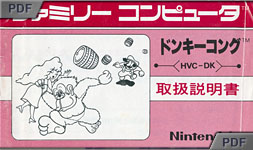
|
|
|
Click on picture to enlarge |
|
|
|
LK

|
|
Add your Pov here !
|
P
O
V
s
|
|
Donkey Kong is a classic among classics, and is definitively the
game that put Nintendo on the map in the US and the rest of the
world. The game shone with a brilliantly simple gameplay and certainly
stood out in the sea of space shooters and maze games that filled the
arcades of the early 80's. So how does this version compare to the
original arcade game ? Graphically, the port is excellent and is as
close as you can get to the original game (within the obvious hardware
limitations of the 8-bit system). Although this version only includes
three levels (as opposed to four in the arcade), the game is still as
fun as the original and the controls are responsive and work exactly as
they should. However, like many early arcade games, Donkey Kong
centers primarily on the concept of a high-score, and as such, some
players may find the game too repetitive (the game just loops
indefinitely after the third screen). Granted, if you look at it with
fresh eyes (and if you're not into the high score thing), the game
is about ten minutes long... So here you have it, Donkey Kong
is definitively a highly-regarded arcade classic (praise that it rightfully deserves),
and this port is
incredibly faithful to the original game (despite the missing screen).
But I feel that it just doesn't really hold up when placed against
the rest of the Famicom library.
|
|
|
|